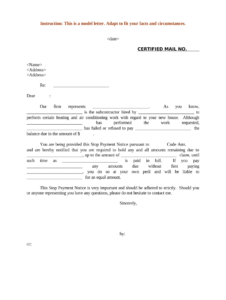Developing a comprehensive Stop Work Authority (SWA) program is crucial for ensuring workplace safety and minimizing risks. To streamline this process, using a well-crafted SWA program template can significantly assist in establishing clear guidelines and procedures.
The Importance of a SWA Program Template
A SWA program template provides a structured framework for organizations to effectively implement safety protocols. It defines the circumstances under which work should be stopped, the roles and responsibilities of individuals authorized to issue stop work orders, the process for communication and documentation, and the consequences for violating SWA procedures.
Using a standardized template ensures consistency in SWA implementation throughout the organization, minimizing confusion and promoting a uniform understanding of safety expectations. It also helps organizations comply with regulatory requirements and industry best practices, reducing legal liabilities and enhancing workplace safety.
Components of a SWA Program Template
A comprehensive SWA program template typically includes the following components:
1. Definition of Stop Work Authority: Clearly outlines the conditions and circumstances that constitute grounds for issuing a stop work order, such as unsafe conditions, equipment malfunctions, or imminent danger.
2. Designation of Authorized Individuals: Specifies the individuals with the authority to issue stop work orders, including supervisors, safety officers, and line managers. Their roles and responsibilities are clearly defined.
3. Issuance Procedure: Describes the process for issuing stop work orders, including the use of verbal or written communication, the required information to be included, and the methods for documenting the order.
4. Communication and Response: Establishes clear communication channels for reporting unsafe conditions and responding to stop work orders. It outlines the roles of supervisors, workers, and other stakeholders in implementing the SWA program.
5. Compliance and Consequences: Clearly outlines the consequences of violating SWA procedures, including disciplinary actions, corrective measures, and potential legal penalties.
Effective Implementation of the SWA Program Template
To ensure the effectiveness of the SWA program template, organizations should take the following steps:
1. Customization: Tailor the template to the specific needs and nature of the organization’s operations, considering factors such as the industry, risks involved, and workforce composition.
2. Training and Communication: Conduct thorough training sessions to educate employees on the SWA program template, its components, and their roles and responsibilities. Clear communication and regular reminders are essential for maintaining awareness and compliance.
3. Regular Review and Evaluation: Regularly review and evaluate the SWA program template to ensure its effectiveness and relevance. Feedback from employees, safety audits, and incident reports can provide valuable insights for ongoing improvement.
By effectively implementing a SWA program template, organizations can establish a proactive and robust safety culture that empowers individuals to protect themselves and others from potential hazards.

